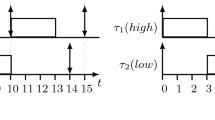Abstract
The analysis of fixed priority preemptive scheduling has been extended in various ways to improve its usefulness for the design of real-time systems. In this paper, we define the layered preemptive priority scheduling policy which generalizes fixed preemptive priorities by combination with other policies in a layered structure. In particular, the combination with the Round Robin scheduling policy is studied. Its compliance with Posix 1003.1b requirements is shown and its timing analysis is provided. For this purpose and as a basis for the analysis of other policies, the concept of majorizing work arrival function, is introduced to synthesize essential ideas used in existing analysis of the fixed preemptive priority policy.
If critical resources are protected by semaphores, the Priority Ceiling Protocol (PCP) can be used under fixed preemptive priorities to control resulting priority inversions. An extension of the PCP is proposed for Round Robin, to allow a global control of priority inversions under the layered priority policy and to prevent deadlocks. The initial timing analysis is extended to account for the effects of the protocol. The results are illustrated by a small test case.
Access this article
Rent this article via DeepDyve
Similar content being viewed by others
Explore related subjects
Discover the latest articles, news and stories from top researchers in related subjects.REFERENCES
Liu, C. L. and J. W. Layland, “Scheduling algorithms for multiprogramming in hard real-time environment,” J. ACM, 20, 40-61 (1973).
Lehozky, J., L. Sha, and Y. Ding, “The rate monotonic scheduling algorithm: Exact characterization and average case behavior,” in Proceedings IEEE Real-Time Systems Symposium, December 1989, pp. 166-171.
Joseph, M. and P. Pandya, “Finding response times in a real-time system,” The Computer Journal, 29, 390-395 (1986).
Lehoczky, J.P., “Fixed priority scheduling of periodic task sets with arbitrary deadlines,” in Proceedings of the 11th IEEE Real-Time Systems Symposium, December 1990, pp. 201-209.
Tindell, K., A. Burns, and A. J. Wellings, “An extendible approach for analysing fixed priority hard real time sytems,” Real-Time Systems, 6(2) (1994).
Sha, L., R. Rajkumar, and J. P. Lehoczky, “Priority inheritance protocols: An approach to real-time synchronization,” IEEE Trans. Comput., 39, 1175-1185 (1990).
(ISO/IEC). “9945-1:1996 (ISO:IEC)[IEEE/ANSI Std 1003.1 1996 Edition] Information Technology—Portable Operating System Interface (POSIX)—Part 1: System Application: Program Interface,” IEEE Standards Press, 1996, ISBN 1-55937-573-6.
Migge, J., “Scheduling of recurrent tasks on one processor: A trajectory based Model,” Université Nice Sophia-Antipolis, 1999. http://www.migge.net/jorn/thesis/.
Mok, A. and D. Chen, “A multiframe model for real-time tasks,” IEEE Trans. Software Eng., 23, 635-645 (1997).
George, L., N. Rivierre, and M. Spuri, “Preemptive and non-preemptive real-time uniprocessor scheduling,” Technical Report 2966, INRIA.
Pushner, P., “Worst-case execution-time analysis at low cost,” Control Eng. Pract., 6, 129-135 (1998).
Park, C. Y., “Predicting program execution times by analyzing static and dynamic programs paths,” Real-Time Syst., 5, 31-62 (1993).
Tindell, K.W., “Fixed priority scheduling of hard real-time systems,” University of York, 1993 http://www.migge.net/jorn/thesis/.
Gallmeister, B. O., Programming for the Real World—Posix 4. O'Reilly & Associates.
Migge, J., Tkrts: A tool for computing response time bounds with a trajectory based model.
Chen, M. and K. Lin, “Dynamic priority ceiling: A concurrency control protocol for real-time systems,” RTS, 2 (1990).
Navet, N. and J. M. Migge, “Fine tuning the scheduling of tasks on posix1003.1b compliant systems,” Research Report 3730, INRIA. ftp://ftp.inria.fr/INRIA/publication/RR/RR-3730.ps.gz.
Butenhof, D. R., Programming with POSIX Threads. Addison-Wesley, 1997.
Author information
Authors and Affiliations
Rights and permissions
About this article
Cite this article
Migge, J., Jean-Marie, A. & Navet, N. Timing Analysis of Compound Scheduling Policies: Application to Posix1003.1B. Journal of Scheduling 6, 457–482 (2003). https://doi.org/10.1023/A:1024806606443
Issue Date:
DOI: https://doi.org/10.1023/A:1024806606443




